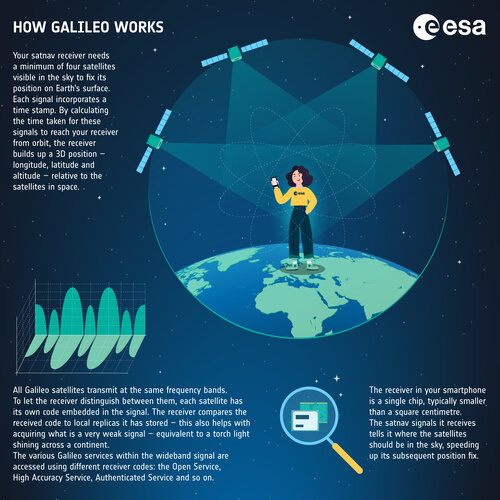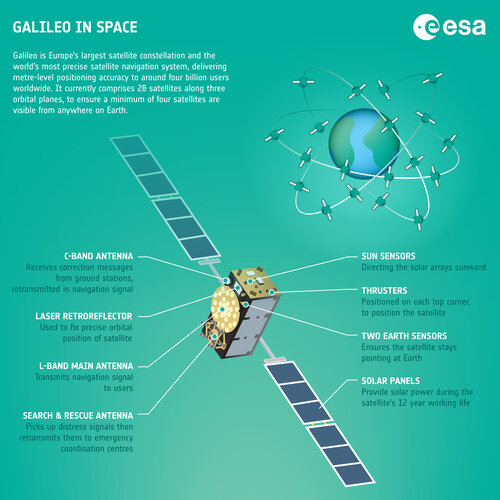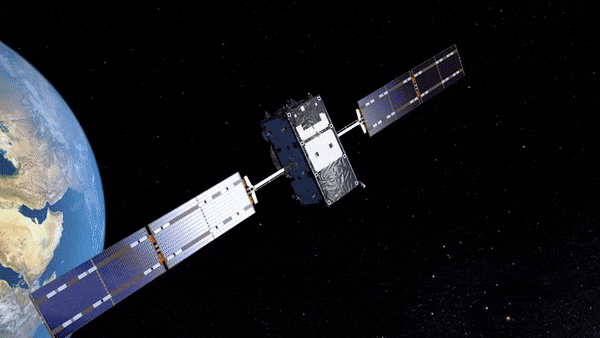
Copernical Team
Monday, 06 March 2023 13:01
How Galileo works - infographic
 Image:
How Galileo works - infographic
Image:
How Galileo works - infographic
Published in
News
Tagged under
Wednesday, 08 March 2023 12:51
Galileo in space – infographic
 Image:
Galileo in space – infographic
Image:
Galileo in space – infographic
Published in
News
Tagged under
Thursday, 09 March 2023 10:30
How does Galileo help other space missions?

In 2023 satnav receivers are everywhere: in our phones, our cars, and drones, in fixed infrastructure, aboard boats, trains and aircraft. They are also in space: more than 95% of all the satellites in low-Earth orbit carry satnav receivers to calculate their position. The additional signals from Europe’s Galileo satellites are providing a big boost to the coverage, availability, redundancy, and accuracy of spaceborne receivers, in turn enlarging the possible scope of future missions, and extending the useful range of satnav much further out into space – to the Moon and beyond.
Published in
News
Tagged under
Thursday, 09 March 2023 07:09
Ceres Imaging expands its agriculture data analytics solutions to Europe
Lisbon, Portugal (SPX) Mar 08, 2023
 Ceres Imaging, the data analytics company that builds precision agriculture solutions to reduce risk and improve sustainability outcomes, is announcing its expansion into Portugal and Spain.
Ceres got its start over a decade ago in California's silicon valley area, and today helps many of the world's largest agriculture land holders detect underperforming assets and identify opportunities
Ceres Imaging, the data analytics company that builds precision agriculture solutions to reduce risk and improve sustainability outcomes, is announcing its expansion into Portugal and Spain.
Ceres got its start over a decade ago in California's silicon valley area, and today helps many of the world's largest agriculture land holders detect underperforming assets and identify opportunities
 Ceres Imaging, the data analytics company that builds precision agriculture solutions to reduce risk and improve sustainability outcomes, is announcing its expansion into Portugal and Spain.
Ceres got its start over a decade ago in California's silicon valley area, and today helps many of the world's largest agriculture land holders detect underperforming assets and identify opportunities
Ceres Imaging, the data analytics company that builds precision agriculture solutions to reduce risk and improve sustainability outcomes, is announcing its expansion into Portugal and Spain.
Ceres got its start over a decade ago in California's silicon valley area, and today helps many of the world's largest agriculture land holders detect underperforming assets and identify opportunities
Published in
News
Tagged under
Thursday, 09 March 2023 07:09
Carbon Mission takes stock of CO2 emissions
Pasadena CA (JPL) Mar 08, 2023
 A NASA Earth-observing satellite has helped researchers track carbon dioxide emissions for more than 100 countries around the world. The pilot project offers a powerful new look at the carbon dioxide being emitted in these countries and how much of it is removed from the atmosphere by forests and other carbon-absorbing "sinks" within their borders. The findings demonstrate how space-based tools
A NASA Earth-observing satellite has helped researchers track carbon dioxide emissions for more than 100 countries around the world. The pilot project offers a powerful new look at the carbon dioxide being emitted in these countries and how much of it is removed from the atmosphere by forests and other carbon-absorbing "sinks" within their borders. The findings demonstrate how space-based tools
 A NASA Earth-observing satellite has helped researchers track carbon dioxide emissions for more than 100 countries around the world. The pilot project offers a powerful new look at the carbon dioxide being emitted in these countries and how much of it is removed from the atmosphere by forests and other carbon-absorbing "sinks" within their borders. The findings demonstrate how space-based tools
A NASA Earth-observing satellite has helped researchers track carbon dioxide emissions for more than 100 countries around the world. The pilot project offers a powerful new look at the carbon dioxide being emitted in these countries and how much of it is removed from the atmosphere by forests and other carbon-absorbing "sinks" within their borders. The findings demonstrate how space-based tools
Published in
News
Tagged under
Thursday, 09 March 2023 07:09
China to launch LEO constellation of remote sensing satellites
Beijing (XNA) Mar 07, 2023
 China Aerospace Science and Industry Corp, a major space contractor, is planning to deploy a remote-sensing satellite network in low-altitude orbits, according to a project leader.
Song Xiaoming, president of the CASIC Second Academy, said that China intends to establish a space-based, high-performance infrastructure system for global remote-sensing operations.
Remote sensing refers
China Aerospace Science and Industry Corp, a major space contractor, is planning to deploy a remote-sensing satellite network in low-altitude orbits, according to a project leader.
Song Xiaoming, president of the CASIC Second Academy, said that China intends to establish a space-based, high-performance infrastructure system for global remote-sensing operations.
Remote sensing refers
 China Aerospace Science and Industry Corp, a major space contractor, is planning to deploy a remote-sensing satellite network in low-altitude orbits, according to a project leader.
Song Xiaoming, president of the CASIC Second Academy, said that China intends to establish a space-based, high-performance infrastructure system for global remote-sensing operations.
Remote sensing refers
China Aerospace Science and Industry Corp, a major space contractor, is planning to deploy a remote-sensing satellite network in low-altitude orbits, according to a project leader.
Song Xiaoming, president of the CASIC Second Academy, said that China intends to establish a space-based, high-performance infrastructure system for global remote-sensing operations.
Remote sensing refers
Published in
News
Tagged under
Thursday, 09 March 2023 07:09
Globalstar introduces Realm Cloud Mobile Device Management Platform
Covington LA (SPX) Mar 09, 2023
 Globalstar, Inc. (NYSE American: GSAT) has unveiled Realm Cloud, an agile mobile device and data management (MDM) platform designed to enable VARs and customers with all the capabilities required to solve speed-to-market needs for deploying and building customized asset tracking and telematics solutions while lowering the cost of ownership.
Designed for an ever-evolving future, Realm Cloud
Globalstar, Inc. (NYSE American: GSAT) has unveiled Realm Cloud, an agile mobile device and data management (MDM) platform designed to enable VARs and customers with all the capabilities required to solve speed-to-market needs for deploying and building customized asset tracking and telematics solutions while lowering the cost of ownership.
Designed for an ever-evolving future, Realm Cloud
 Globalstar, Inc. (NYSE American: GSAT) has unveiled Realm Cloud, an agile mobile device and data management (MDM) platform designed to enable VARs and customers with all the capabilities required to solve speed-to-market needs for deploying and building customized asset tracking and telematics solutions while lowering the cost of ownership.
Designed for an ever-evolving future, Realm Cloud
Globalstar, Inc. (NYSE American: GSAT) has unveiled Realm Cloud, an agile mobile device and data management (MDM) platform designed to enable VARs and customers with all the capabilities required to solve speed-to-market needs for deploying and building customized asset tracking and telematics solutions while lowering the cost of ownership.
Designed for an ever-evolving future, Realm Cloud
Published in
News
Tagged under
Thursday, 09 March 2023 07:09
Maxar awards L3Harris large deployable reflectors contract
Melbourne FL (SPX) Mar 09, 2023
 L3Harris Technologies (NYSE: LHX) has announced a contract from Maxar Technologies to design and build reflector antennas for two geostationary communication satellites.
The two nine-meter unfurlable mesh reflector antennas will provide high-power signals and improved service quality across the satellites' coverage areas. Similar to an umbrella, the flexible architecture of the antenna mak
L3Harris Technologies (NYSE: LHX) has announced a contract from Maxar Technologies to design and build reflector antennas for two geostationary communication satellites.
The two nine-meter unfurlable mesh reflector antennas will provide high-power signals and improved service quality across the satellites' coverage areas. Similar to an umbrella, the flexible architecture of the antenna mak
 L3Harris Technologies (NYSE: LHX) has announced a contract from Maxar Technologies to design and build reflector antennas for two geostationary communication satellites.
The two nine-meter unfurlable mesh reflector antennas will provide high-power signals and improved service quality across the satellites' coverage areas. Similar to an umbrella, the flexible architecture of the antenna mak
L3Harris Technologies (NYSE: LHX) has announced a contract from Maxar Technologies to design and build reflector antennas for two geostationary communication satellites.
The two nine-meter unfurlable mesh reflector antennas will provide high-power signals and improved service quality across the satellites' coverage areas. Similar to an umbrella, the flexible architecture of the antenna mak
Published in
News
Tagged under
Thursday, 09 March 2023 07:09
Navigation Lab exploring Galileo's future - and beyond
Paris (ESA) Mar 09, 2023
 Would you like to know the future of satellite navigation? Try ESA's Navigation Laboratory. This is a site where navigation engineers test prototypes of tomorrow's user receivers, using simulated versions of the navigation signals planned for the coming decade, such as set to be transmitted from Galileo's Second Generation satellites.
Jose Antonio Garcia Molina, heading ESA's Radio Navigat
Would you like to know the future of satellite navigation? Try ESA's Navigation Laboratory. This is a site where navigation engineers test prototypes of tomorrow's user receivers, using simulated versions of the navigation signals planned for the coming decade, such as set to be transmitted from Galileo's Second Generation satellites.
Jose Antonio Garcia Molina, heading ESA's Radio Navigat
 Would you like to know the future of satellite navigation? Try ESA's Navigation Laboratory. This is a site where navigation engineers test prototypes of tomorrow's user receivers, using simulated versions of the navigation signals planned for the coming decade, such as set to be transmitted from Galileo's Second Generation satellites.
Jose Antonio Garcia Molina, heading ESA's Radio Navigat
Would you like to know the future of satellite navigation? Try ESA's Navigation Laboratory. This is a site where navigation engineers test prototypes of tomorrow's user receivers, using simulated versions of the navigation signals planned for the coming decade, such as set to be transmitted from Galileo's Second Generation satellites.
Jose Antonio Garcia Molina, heading ESA's Radio Navigat
Published in
News
Tagged under
Thursday, 09 March 2023 07:09
SatixFy and Kythera Space solutions partner to deliver advanced payload solutions for LEO constellations
Rehovot, Israel (SPX) Mar 09, 2023
 SatixFy Communications Ltd. ("SatixFy") (NYSE AMERICAN: SATX), a leader in next-generation satellite communication technology solutions from chip to product, and Kythera Space Solutions ("Kythera"), the leader in dynamic management systems for next-generation payloads and SATCOM networks, announced that they have partnered to deliver advanced payload solutions for LEO constellations.
Satix
SatixFy Communications Ltd. ("SatixFy") (NYSE AMERICAN: SATX), a leader in next-generation satellite communication technology solutions from chip to product, and Kythera Space Solutions ("Kythera"), the leader in dynamic management systems for next-generation payloads and SATCOM networks, announced that they have partnered to deliver advanced payload solutions for LEO constellations.
Satix
 SatixFy Communications Ltd. ("SatixFy") (NYSE AMERICAN: SATX), a leader in next-generation satellite communication technology solutions from chip to product, and Kythera Space Solutions ("Kythera"), the leader in dynamic management systems for next-generation payloads and SATCOM networks, announced that they have partnered to deliver advanced payload solutions for LEO constellations.
Satix
SatixFy Communications Ltd. ("SatixFy") (NYSE AMERICAN: SATX), a leader in next-generation satellite communication technology solutions from chip to product, and Kythera Space Solutions ("Kythera"), the leader in dynamic management systems for next-generation payloads and SATCOM networks, announced that they have partnered to deliver advanced payload solutions for LEO constellations.
Satix
Published in
News
Tagged under
